Natural Areas and National Natural Landmarks
A Natural Area is an area within a state park of unique scenic, geologic, or ecological value which will be maintained in a natural condition by allowing physical and biological processes to operate usually without direct human intervention. These areas are set aside to:
A
National Natural Landmark is a nationally significant natural area that has been designated by the Secretary of the Interior. To be nationally significant, an area must be one of the best examples of a type of biological community or geological feature in a physiographic province. Of the 22 state park natural areas, seven are National Natural Landmarks. There are seven National Natural Landmarks in five of the state forests of Pennsylvania.
Navigate with the map or view the chart below. Select a region on the map or zoom in on the map using the zoom tool on the left. Clicking on a state park on the map will reveal an information box with a listing of amenities in the park. More information on these areas and landmarks is listed below.
Northern Pennsylvania State Park Natural Areas
Black Moshannon State Park -- Black Moshannon Bogs
The Black Moshannon Bogs at
Black Moshannon State Park are wetlands adjacent to the southwest arm of the lake comprise the finest reconstructed bog in Pennsylvania. Includes many rare plants associated with sphagnum bogs.
Colton Point State Park and Leonard Harrison State Park -- Pine Creek Gorge
Both
Colton Point State Park and
Leonard Harrison State Park are surrounding Pine Creek Gorge, a portion of the Pennsylvania Grand Canyon. Park vistas on east and west rims overlook the scenic gorge that contains rare plants. Pine Creek Gorge is recognized as a National Natural Landmark.
Raymond B. Winter State Park -- Rapid Run
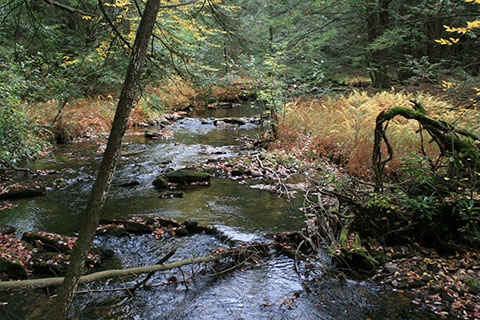
Raymond B. Winter State Park's Rapid Run is 39 acres of old growth forest of white pine and eastern hemlock containing areas of emergent wetlands, springs, and sphagnum bogs.
Eastern Pennsylvania State Park Natural Areas
Delaware Canal State Park -- Nockamixon Cliffs and River Islands

Delaware Canal State Park's Nockamixon Cliffs rise nearly 300 feet above the Delaware River and provides habitat for rare alpine species of concern.
The
River Islands are 80 acres of seven different islands in the Delaware River containing natural plant communities and many rare plants.
French Creek State Park -- Pine Swamp
.jpg)
Pine Swamp at
French Creek State Park is 90 acres of acidic broadleaf swamp containing rare plant species. With characteristics such as vegetated sphagnum hummocks and mucky, water-filled channels.
Hickory Run State Park -- Boulder Field, Mud Run, and Mud Swamp
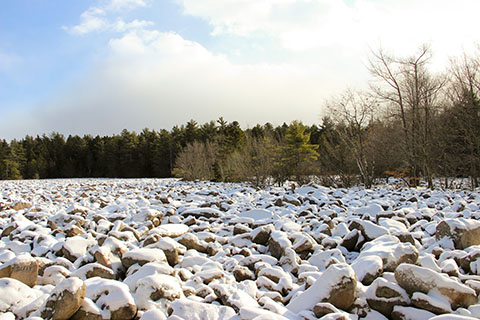
Boulder Field at
Hickory Run State Park is a unique, geologically significant field of unsorted, loosely packed boulders resulting from periglacial conditions.
The large size of the boulders and the low (1 percent) gradient of the field make it nationally unique.
Boulder Field is recognized as a National Natural Landmark.
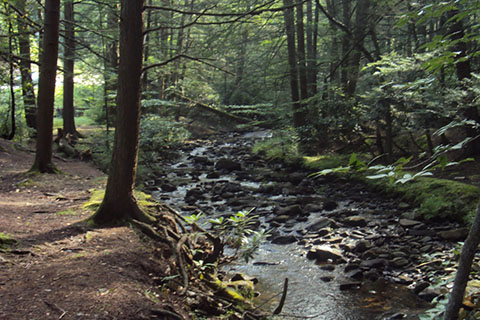
Mud Run is 1,335 acres with a remote mountain stream filled with a viable native trout population, lined with rhododendron and eastern hemlock, buffered by mature hardwood forest.

Mud Swamp is a remote emergent wetland containing rare plant species of concern.
Neshaminy State Park -- Neshaminy Tidal Marsh
Neshaminy State Park's Neshaminy Tidal Marsh is 70 acres of freshwater intertidal zone along the shores of the Delaware River and Neshaminy Creek containing many rare plants.
Ricketts Glen State Park -- Glen Natural Area
Ricketts Glen State Park's Glens Natural Area is a relict eastern deciduous forest containing examples of stream erosion and spectacular waterfalls. The Glens Natural Area is recognized as a National Natural Landmark.
Salt Springs State Park -- Fall Brook
Salt Springs State Park's Fall Brook is 34 acres containing many old-growth hemlocks and a steep gorge with a picturesque stream and several waterfalls.
Tobyhanna State Park -- Black Bear and Bender Swamps
Tobyhanna State Park's Black Bear and Bender Swamps are acidic shrub swamps with openings containing sphagnum moss, rare plants, and animals.
Western Pennsylvania State Park Natural Areas
Cook Forest State Park -- Cook Forest and Swamp Forest
Cook Forest State Park's Cook Forest is a relic of the forest type that once covered northern Pennsylvania.
The forest is predominately comprised of Eastern white pine along with Eastern hemlocks and mixed hardwood tree species. Many of the trees are over 300 years old.
Cook Forest is recognized as a National Natural Landmark.

Swamp Forest has a perched water table that gives rise to palustrine wetland of old growth eastern hemlocks and white pines at the headwaters of Brown’s Run.
Laurel Hill State Park -- Hemlock Trail
Laurel Hill State Park's Hemlock Trail is a scenic area of old growth eastern hemlock. This area includes a picturesque portion of Laurel Hill Creek which contains a viable native trout population.
McConnell's Mill State Park
McConnell's Mill State Park is an outstanding geological example of land and watershed formation indirectly resulting from glacial diversion of a stream. An important secondary characteristic at this site is the surrounding old growth forest.
McConnells Mill State Park is recognized as a National Natural Landmark.
Moraine State Park -- Slippery Rock Wetlands
Slippery Rock Wetlands at
Moraine State Park is 92 acres of floodplain forest filled with northern hardwoods and adjacent palustrine and shrub-scrub wetlands containing diverse and rare plants.
Ohiopyle State Park -- Ferncliff Peninsula
Ferncliff Peninsula at
Ohiopyle State Park is a peninsula formed by a bend in the Youghiogheny River. The area contains abundant wildflowers, old growth hemlocks, mixed oak forests, and plant species of concern.
Ferncliff Peninsula is recognized as a National Natural Landmark.
Presque Isle State Park
Presque Isle State Park is a peninsula, or "flying spit", formed by sands carried by the currents of Lake Erie. It is an impressive illustration of this type of formation and is the largest in the Great Lakes region.
The park has a large variety of habitats (bay, sand dune, heath, marsh, pond, etc.) which are critical for migrating shore birds and waterfowl. Provides habitats for many rare plants and animals.
Presque Isle is recognized as a National Natural Landmark.
Pymatuning State Park -- Black Jack Swamp and Clark Island
Black Jack Swamp at
Pymatuning State Park is a palustrine scrub-shrub and emergent wetlands adjacent to Pymatuning Lake. It provides habitat for plant and animal species of concern.
Clark Island is 161 acres of mature forest of hardwoods and white pines containing an inland, lake-fed pond. It provides habitat for plant species of concern.
State Forest Natural Areas
Bald Eagle State Forest -- Snyder-Middleswarth Natural Area
The Snyder-Middleswarth Natural Area in
Bald Eagle State Forest is an outstanding example of a relict forest composed predominantly of hemlock, birch, and pine, with scattered oaks.
The Snyder-Middleswarth Natural Area is recognized as a National Natural Landmark.
Rothrock State Forest -- Bear Meadows Natural Area
Bear Meadows Natural Area, located within
Rothrock State Forest, includes a shallow peat bog surrounded by a buffer zone of typical Appalachian forest.
The vast accumulation of pollen and spores in the peat has aided research and understanding of vegetation and climatic changes in the region. Bear Meadows Natural Area is recognized as a National Natural Landmark.
Sproul State Forest -- Tamarack Swamp
Tamarack Swamp in
Sproul State Forest is an outstanding example of a large headwater swamp occurring in a glacially blocked stream valley.
The two bogs, rich in wetland vegetation and including rare species, are the finest examples of acid kettle hole bogs in glaciated northwestern Pennsylvania.
Tamarack Swamp is recognized as a National Natural Landmark.
Tioga State Forest -- Pine Creek Gorge, Reynolds Spring, and Algerine Swamp Bogs
Pine Creek Gorge in Tioga State Forest contains superlative scenery, geological and ecological value, and is one of the finest examples of a deep gorge in the eastern United States.
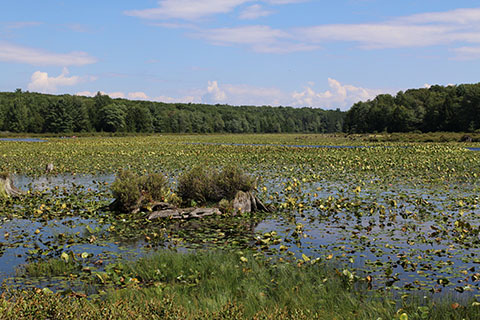
Reynolds Spring and Algerine Swamp Bogs contains one of the finest and most representative high mountain bogs in the Allegheny Mountains section of Pennsylvania. The site is located primarily within Tioga State Forest.
Both areas are recognized as National Natural Landmarks.
Tuscarora State Forest -- Hemlocks Natural Area and Box Huckleberry Site
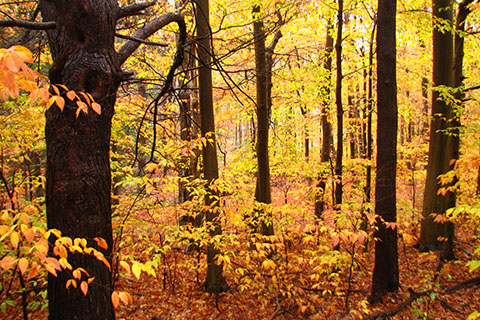
Hemlocks Natural Area in Tuscarora State Forest contains a virgin forest that has more resemblance to the hemlock-northern hardwood forests than to the oak-chestnut forests in which it is located.
Box Huckleberry site is one of the few localities where the unusual box huckleberry plant is found. Box huckleberry is one of the oldest living organisms in the world.
Both are recognized as National Natural Landmarks.